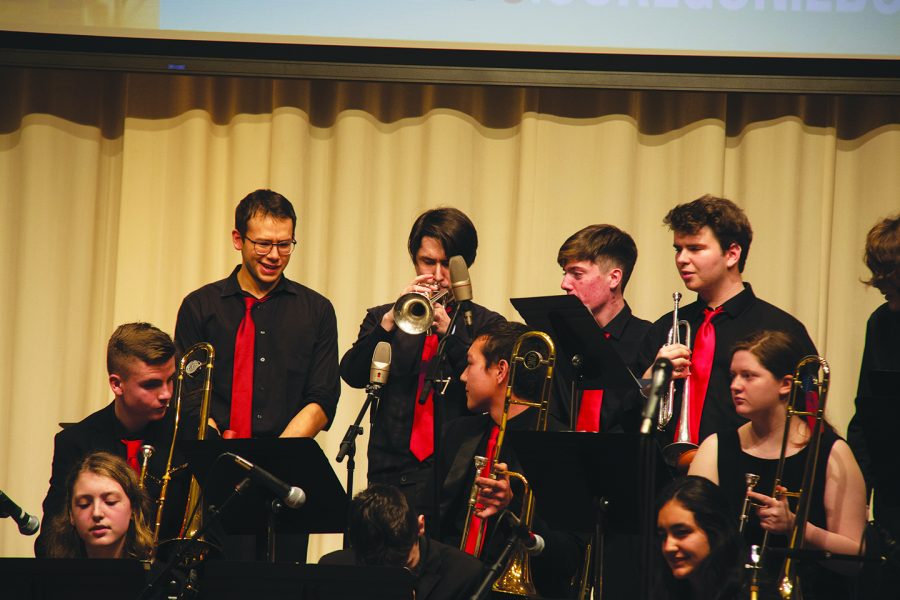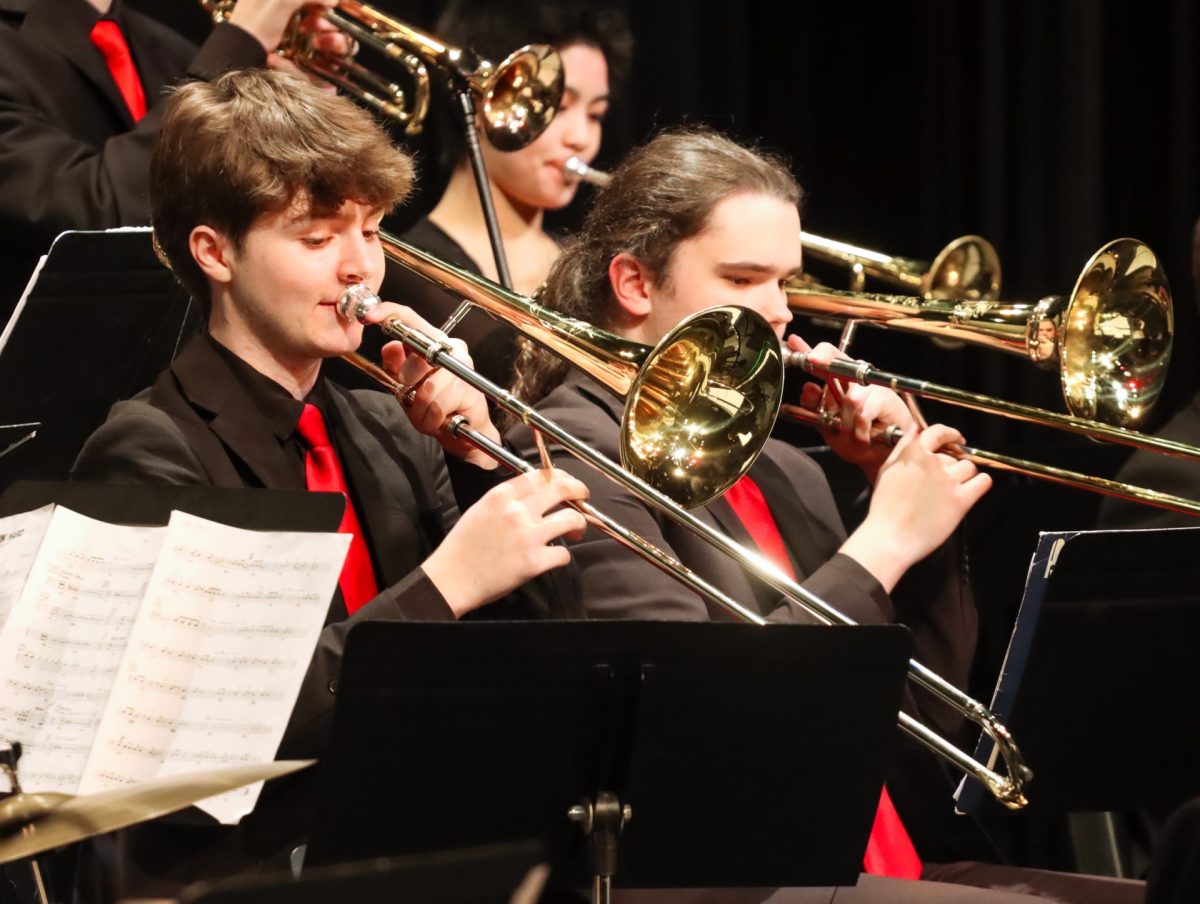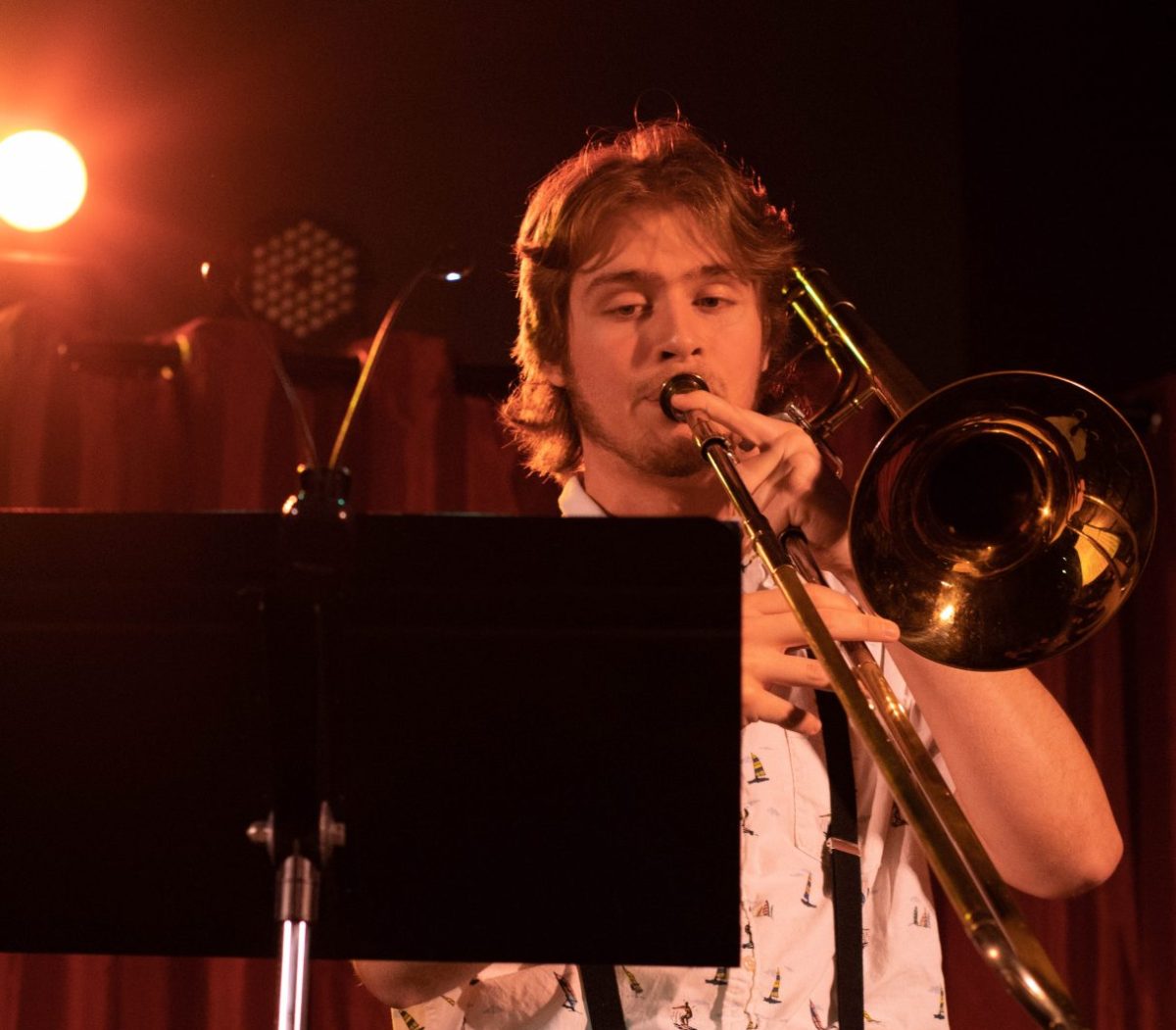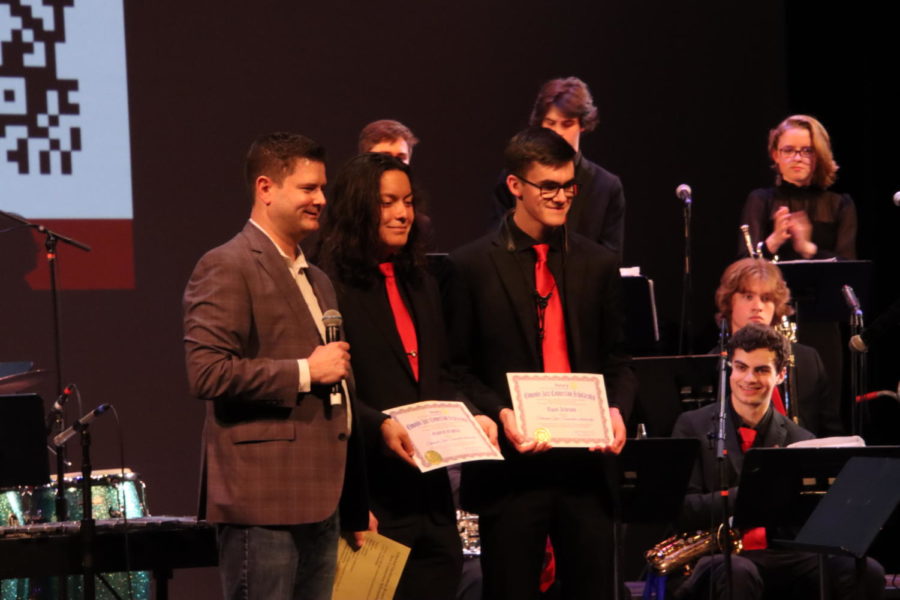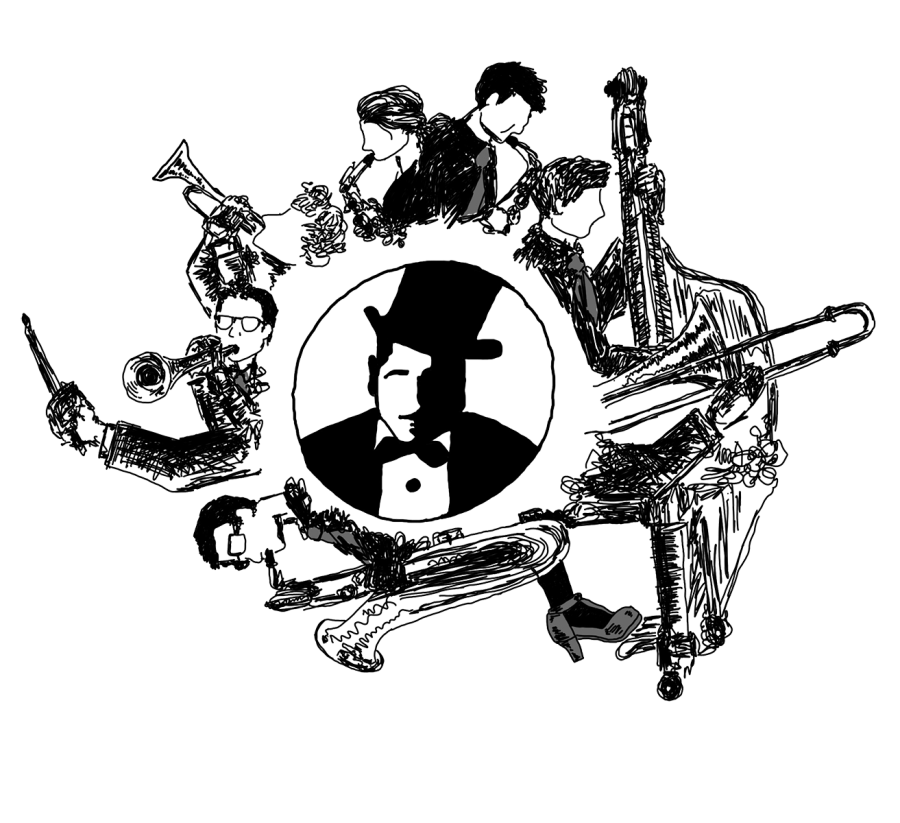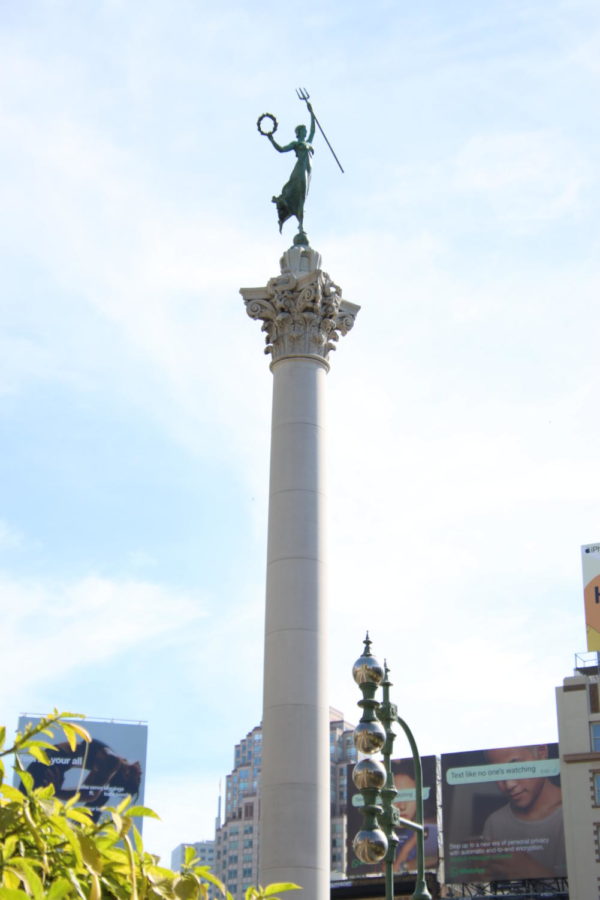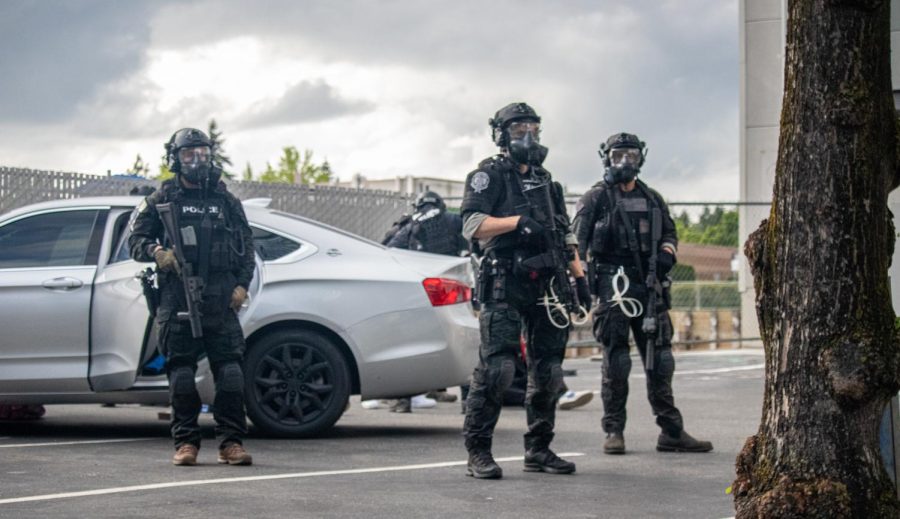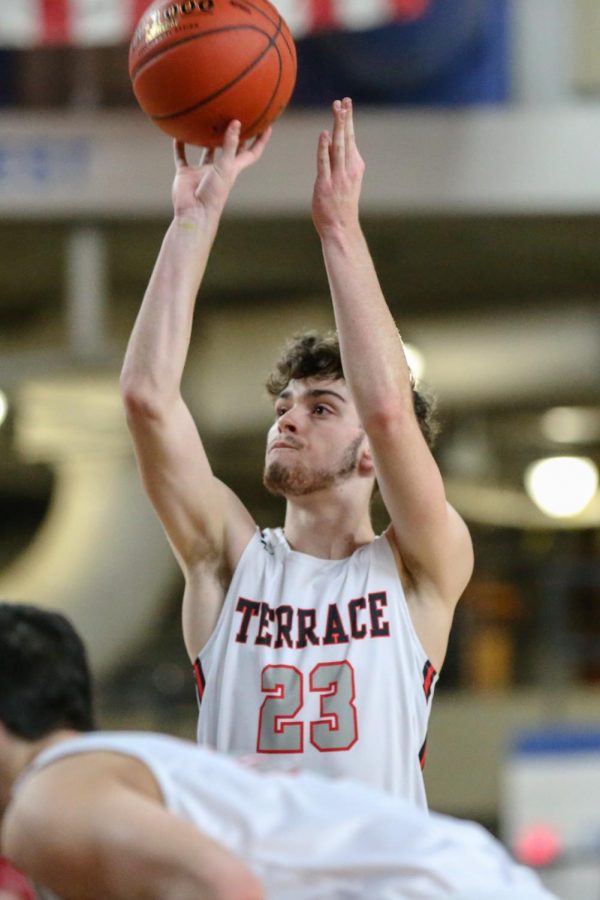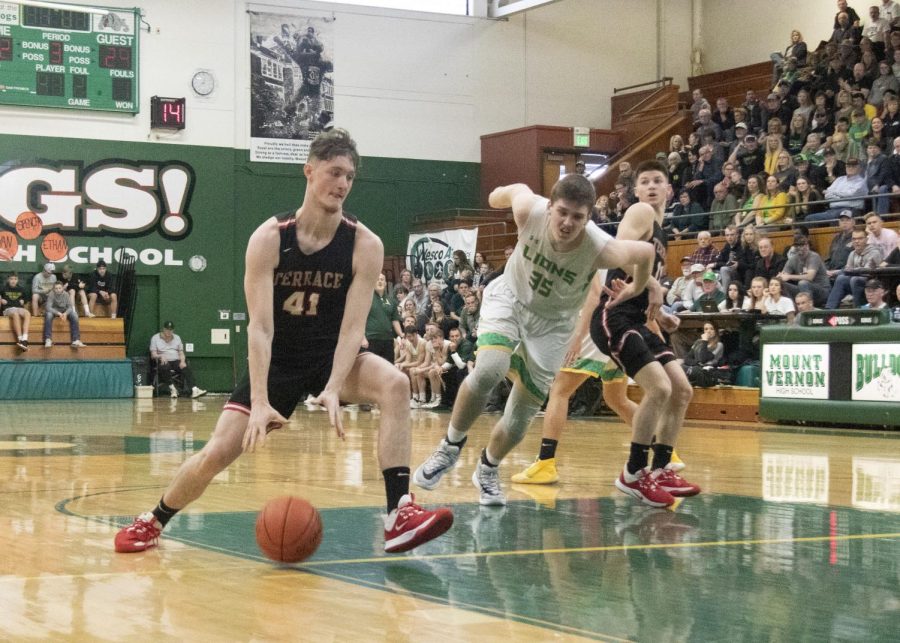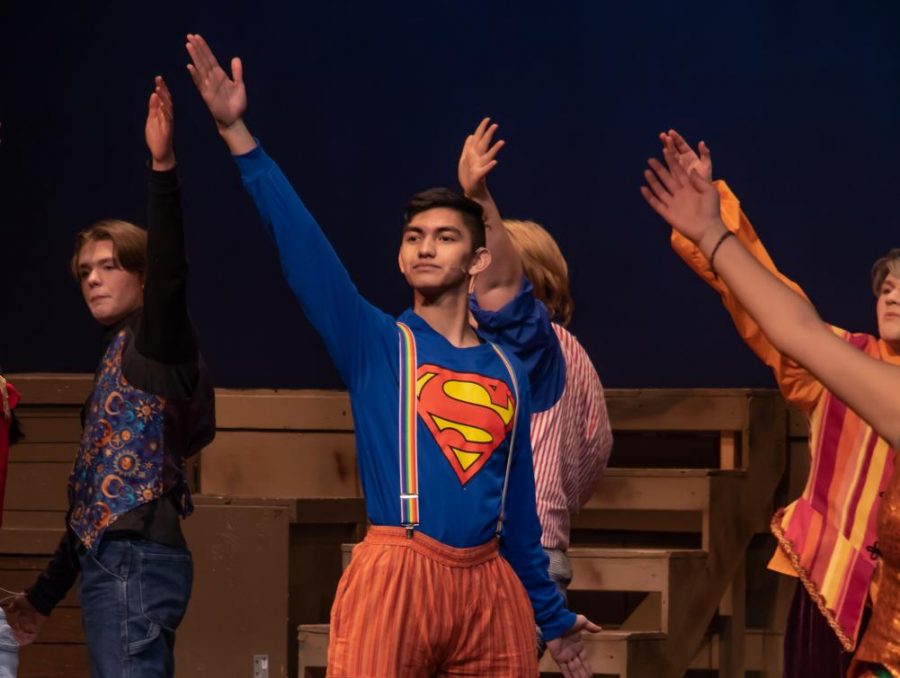After 300 miles on the road, senior jazz 2 pianist Lindee Cutler and I joined the rest of the band halfway through featured artist Sean Jones’ set, with drummer Chris Brown, bassist Dave Captein and George Colligan on piano. The former Jazz at Lincoln Center lead trumpet’s quartet was midway through “My Favorite Things,” and it was immediately apparent why he was headlining this festival. His capacity for improvisation and his soloing agility made for an astonishing performance.
Next was “Gretchen,” a piece he wrote as a present for his record label’s executive.
“I made a promise to the label owner, Gretchen Valade, ‘I’m going to write a song for you!’ and she looked at me and said, ‘Yeah, whatever.’ Well, thirteen or fourteen years later, I thought to myself…’I never wrote Gretchen that composition. I’m going to do that now.”
Jones overnighted the framed copies to her and and called her up a month later.
“I said, ‘What’d you think?’ and she said, “Better late than never.’”
It’s got a Christmas crooner quality about it, the way the chords melt together. It all seemed very wistful, inspired by the snowfall outside of where Jones lived in Boston.
Jones, a wonderful storyteller, illuminated each chart with a feeling of instant familiarity.
“This next song is a tribute, by Freddy Hubbard, to the great John Coltrane,” Jones hinted.
Seniors Josh Setala, Caden Hargrave and Ernesto Torres, as well as junior Andrew Vinther, bristled with excitement. Cutler, sitting between them and I, offered clarity.
“It’s ‘Dear John.’ They’ve been working on this song for months,” she whispered.
“Dear John” is played over the same chord progression as “Giant Steps,” one of jazz’s most legendarily difficult songs. John Coltrane’s solo is considered the apex of the Bebop movement, with a mathematical complexity mind-boggling to conceptualize.
Each musician delivered precise, break-neck solos true to the spirit of Coltrane. The standout of this piece was a 16-minute drum solo from Brown.
Brown already impressed the audience with his technical dexterity and showmanship. The fluidity of his movements, coupled with his heavily embellished style, meant a memorable performance. But, all of this was nothing compared to his solo on “Dear John.”
Brown began with the head, or the main melody, of “Giant Steps.” This is a typical way for solos to begin. But, Brown is on a drum set. Somehow, he negotiated the complicated melody on his cymbals. His monstrous solo captivated his band members and the audience. Raw passion emanated from the kit as Brown beat upon it, occasionally emphasizing with a boyish, stuck-out tongue. He traded smirks with Jones as they swapped solos. Competing playfully, each one outdid their previous solo with even more musical acrobatics. Brown dropped his sticks, and without missing a beat, flicked up a new pair to catch in mid-air.
Jones defied student trumpeter’s common sense, playing chop-busting licks into higher and higher registers. Their set culminated in a breathless standing ovation from the audience.
The combined MTHS jazz bands left for their hotel. It was 10 p.m., and they’d soon rise for the 12-hour festival beginning at 7 a.m.
Winding down in our room, pianists Natalie Song and Cutler, as well as guitarist Sienna McLaren, discussed their apprehensions for the day ahead.
“Our combo plays at 7:30, Jazz 3 plays at 7:45, everything overlaps,” explained Song.
“My biggest concern is just how chaotic it’s going to be,” McLaren said.
There was reflection, too. A year after we attended this festival for the first time, a high expectation was set when MTHS was chosen for the final concert.
“After last year, I feel like I’m playing better and I feel good about what I’m playing,” Song said, while brushing her teeth. “Yeah, I feel good.”
After breakfast, students boarded the bus toward Beall Hall. Two groups performed simultaneously, a Jazz 1 combo consisting of Song, Vinther, Setala, Torres and Hargrave, and a Jazz 3 main hall performance.
“We’re getting ready to play with our combo, the staff is telling us we’re locked out of our warmup room, so we have 30 minutes of just chilling in the hallway,” Setala said, setting a brisk pace with his long strides. “I’m worried about our first set.”
“It’s all new tunes, we’ve never played them before,” added Vinther, whom we had just run into.
“We’ve played “Dear John’ once,” corrected Setala.
The rhythm section gathered around a piano they found in a dead-end hallway, discussing last-minute set details. Hargrave and Torres were in the now-unlocked practice room, information which I forwarded to the rest of the combo.
Song realized the practice room lacked a piano, so she reviewed her lead sheets again. This was their first opportunity to practice since picking their songs the day prior. And, because of the practice room shenanigans, they had a half hour to get their act together. Their set consisted of “Ramblin” by Ornette Coleman, “Central Park West” by John Coltrane and naturally, “Dear John.”
“Ramblin” went well, it’s a fun piece with a funky groove which Torres and Hargrave solo together on, trading back and forth and occasionally playing simultaneously, to pleasantly chaotic effect. Song nodded along, Setala and Vinther couldn’t help but grin.
“Natalie, I love how much space you’re leaving,” quipped Setala.
“Honestly, your nodding was the only thing keeping me in time,” Hargrave added.
Next, “Dear John.”
“When Lindee said we’d been preparing this song for months, she actually meant we played it once, months ago,” mentioned Torres.
They’d also have to live up to Jones’ performance last night. Running through it, they were delighted to discover they’d made it through just fine.
Finally, “Central Park West.” Their rehearsal, however, was interrupted as their guide knocked on the door and led them to the performance auditorium.
Clinician David Glenn cut a shadowy figure against the back wall of the cavernous space and scribbled notes as the combo ran through their set. Though it went well, there was a small spot of trouble. During “Central Park West,” Hargrave got lost and had a difficult time recovering. Nonetheless, the remarkable work he and the rest of the band did on the other pieces made it all in all an exciting performance for an intimate audience.
Glenn emerged from the shadows, becoming much less intimidating with a flocking of candy-floss hair and a cabled cardigan.He gave a kindhearted chuckle.
“What are you doing to yourselves? I’m looking at this and really, ‘Dear John?’ Are you kidding me!”
“We’ve never played the full set together,” Torres said, widening Glenn’s incredulous smile.
“Really? Oh my God. Own up everything. It was really, really good,” Glenn said.
During the next 45 minutes, they dissected each song, beginning with “Central Park West.” Glenn immediately honed in on Hargrave’s confusion whilst soloing. A slight difference in Hargrave’s lead sheet and the rest of the band’s meant Hargrave soloed over an incorrect chord.
After more advice from Glenn, they had just enough time to join the audience in the main hall for Jazz 2’s performance. Opening with “Just Friends,” a song about lovers drifting apart, Jazz 2’s chosen arrangement seems rather upbeat and shiny given the context. Although it may have started as a melancholy tune, Charlie Parker’s uptempo interpretation set a precedent more commonly followed today. Soloists included talented junior Jonas Riviera on the tenor sax, Cutler on the keys and sophomore Nate Klaussen on the drums.
Their last song, “Maiden Voyage,” was by Herbie Hancock, a pianist known for his continual innovation and experimentation. Meant to evoke a sea-scape, this chart rolls and flows at a quick and steady clip. Riviera killed it on the tenor, with a roaming solo played deftly over changes. A funky piano breakdown cut through the piece, building anticipation for a release that came amidst a wash of china hits.
Met with generous applause, the band cleared off the stage and headed to the student lounge to grab lunch. They’d made it halfway.
Retracing their steps through the cemetery in the middle of campus, the entire group squeezed back into the auditorium to listen to Jones’ “Meet the Artist” session. He was eloquent, charisma evident in every word and likability pervasive throughout his entire presence. Off the cuff, he conjured up quotable pieces of wisdom, indicating improvisational skills reaching beyond the trumpet.
He grew up in a small Ohioan town with no jazz scene to speak of, commuting to Columbus to play gigs that hardly paid for the gas he burned. He was living proof that success in this field took dedication, commitment, practice and the help of instructors.
“I remember all of [my teachers] because they all took the time for me,” Jones said. “I was extremely lucky, and because of them I went to get an education in jazz.”
Jones recalled the experience that cemented his passion for jazz. His sixth-grade band director, Jessica Turner, gave him two CDs: “Kind of Blue” and “Tutu,” snapshots of Miles Davis from two very different points in his career.
“Fast forward 20 years from sixth-grade, I was called by Marcus Miller [Davis’ bassist] to go on a tour called Tutu Revisited where we played the entire album throughout Europe for about two months. I had the opportunity to call Ms. Turner up, and I put her on the phone with … Marcus Miller. When we played the Hollywood Bowl, I flew her out there, and that was kinda cool.”
He finished the hour-long session with an anecdote from his teenage years, when he toured with a select student band around Europe. In Italy, jet-lagged and hungover, he told himself he owed it to the audience to perform well. After the concert, an old man came up to him, holding his chest and sobbing in Italian.
“So I got the translator to come over, and he started talking to her, and she started crying too. I said, ‘What’s going on with this guy?’ and she said that morning, this man was contemplating euthanasia. He wanted to end his life — tomorrow. And he said, because he heard [my] trumpet, he wants to continue to live because there were more beautiful things in the world to experience.”
Jones’ testimony fresh in their minds, Jazz 1 began their rehearsal in the same room as last year, still missing a drum set, to iron out wrinkles in their set.
“I like your look there, Solomon. Very 70s. You need more chest hair, though,” Faul said, in regard to senior trumpeter Solomon Plourd’s unbuttoned shirt. As Torres went to unbutton his all the way (“Man, it’s hot in here!”), Faul quickly intervened. “That’s a little much.”
Screwball antics gave way to a productive rehearsal, and they were soon backstage.
“Fate resides in the intersection of preparation and opportunity,” coached Faul. “Sean Jones just said that.”
“Manifest your destiny!” a student heckled.
Their performance of songs they recorded for Essentially Ellington went smashingly. The audience of clinicians and students from other schools was responsive and invested.
“Well, it looks like the more Jim Sisko [director of Bellevue College’s jazz band] yells at me and the more I cry, the better I get,” remarked Torres after the set, regarding his successful blues solo.
“My face is the same color as my tie,” Setala said, flushed after an athletic performance on “Kinda Dukish/Rockin’ in Rhythm.”
The band congregated around the doors to the clinician room, where they would receive notes on their performance.
“I swear, if it’s another Steve Owens clinic where he goes, ‘Oh wow, you guys sounded great!’ I’m just going to leave,” Setala said.
While Jazz 1 set up in the large room, Dan Gailey, the Director of Jazz Studies at the University of Kansas, walked in.
“Wow. You guys did fantastic,” beamed Gailey. His only critiques were that the bass didn’t seem to resonate, which may have been a technical difficulty, and Setala’s modern, small-group style seemed anachronistic at times. Steve Owens walked in, complimenting the bass, drums, alto sax and the cohesiveness of the band.
As they had hoped, news soon came they were the high school band chosen for the final concert. They met in the clinician room to rehearse, as a much larger audience jostled for seats in the auditorium. Lane Community College and the University of Oregon bands played, featuring Sean Jones. Next, Shasta Middle School, demonstrating skills well beyond the realm of what one expects from a middle school, with adept soloists and surprising selections.
Finally, Jazz 1 took stage for the second time that evening. Faul, uncharacteristically, gave no introduction. Launching straight into “Kinda Dukish” with renewed vigor, Setala rode his china cymbal and somehow played the head in facsimile of Chris Brown’s performance the night prior.
Then, instead of heading into “Rockin’ in Rhythm,” Song hit the train-whistle chord of “Happy Go Lucky Local.” Junior Emily Sallee and Hargrave grinned as they swapped sax solos during the intro. Torres milked the braying, bucktoothed solo he had, dragging it out as long as he could. Vinther’s capability shone during elaborate bass fills. Song’s ragtime solo played well under the following sax solo and Torres’ blues trumpet.
Jones, trumpet in hand, looked on from side-stage with near-admiration. His engagement increased, as he began to tap his foot.
A trombone solo from senior Alec Raring, who has more of an opportunity this year to show off his soloing chops as section leader, followed a more contemporary solo from Hargrave that stretched to the very top of his range.
Jones, to the audience’s surprise, walked out on stage for a solo. Clearly, blues chords were in his blood, as the way he played over them was masterfully evocative, riling up the audience to an even further extent. After the extended solo section, Jones joined the big band to play the last chorus.
Senior Owen Moreland’s clarinet soared to heights unheard and the band reached a feverish pitch, Jones throwing his notes as high as he could get them, and Setala adding multi-faceted fills that added further density and complexity to the chaotic song. It quickly sank down to a surreptitious ending, slinking away with a few notes from the bari sax.
The audience erupted, whooping and hollering as Faul yelled soloist credits. They rose to their feet for the sole standing ovation of the night, only ceasing to clap once the band was well off stage. Tonight’s concert captured technical precision and improvisational brilliance, without seeming too stiff-necked. The energy that the youthful band brought rocked the room, and is what would get them into Essentially Ellington.
I caught up with the band outside of the clinician room.
“It was Faul’s idea to go from ‘Kinda Dukish’ to ‘Happy Go Lucky,’” explained Torres, riding post-concert exhilaration.
But, how did they get Sean Jones to play with them?
“We just asked!” answered Vinther breathlessly.
Setala nodded behind him. “Did you know Sean was staying at our hotel?”

